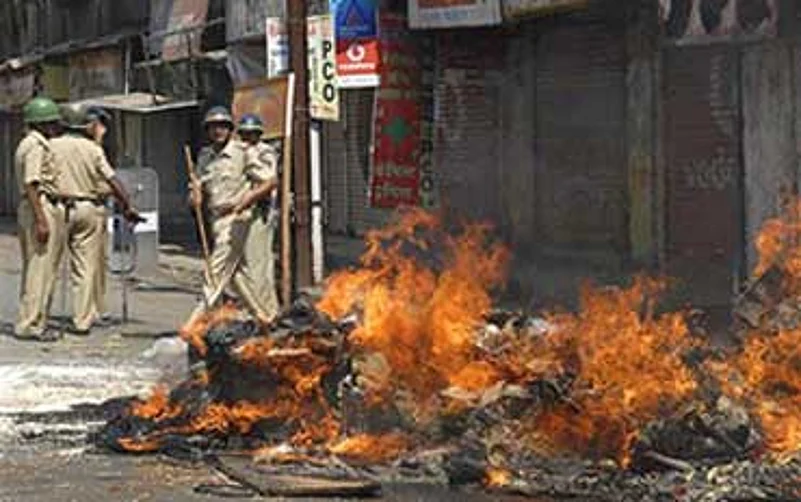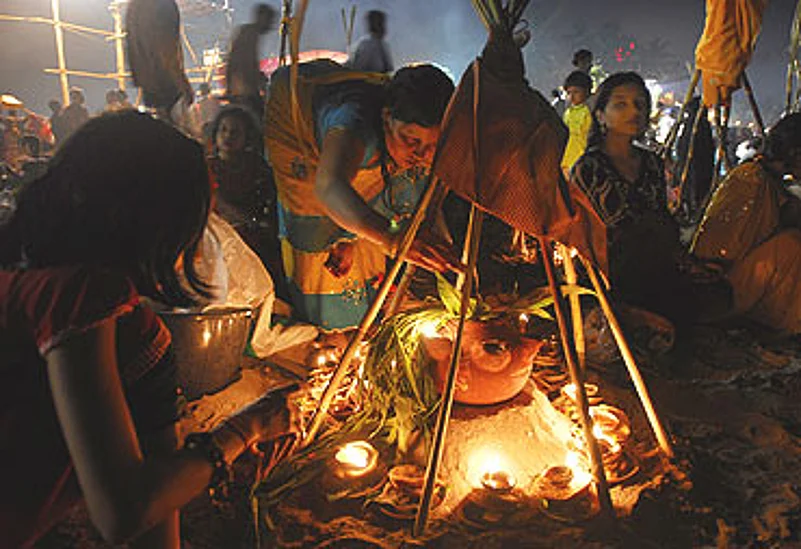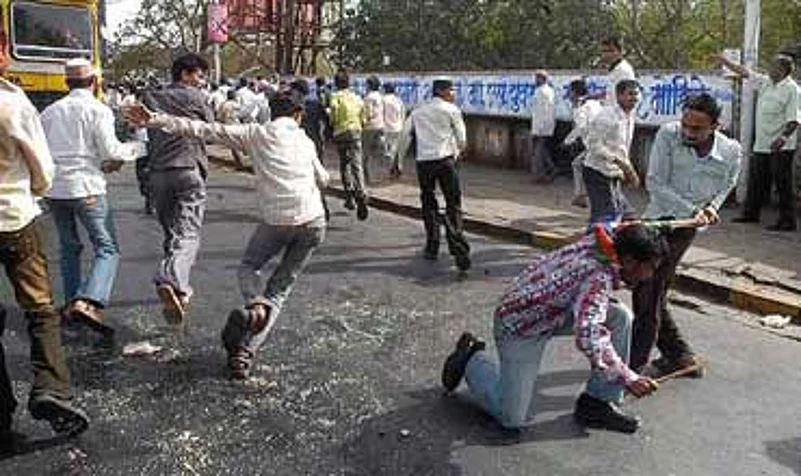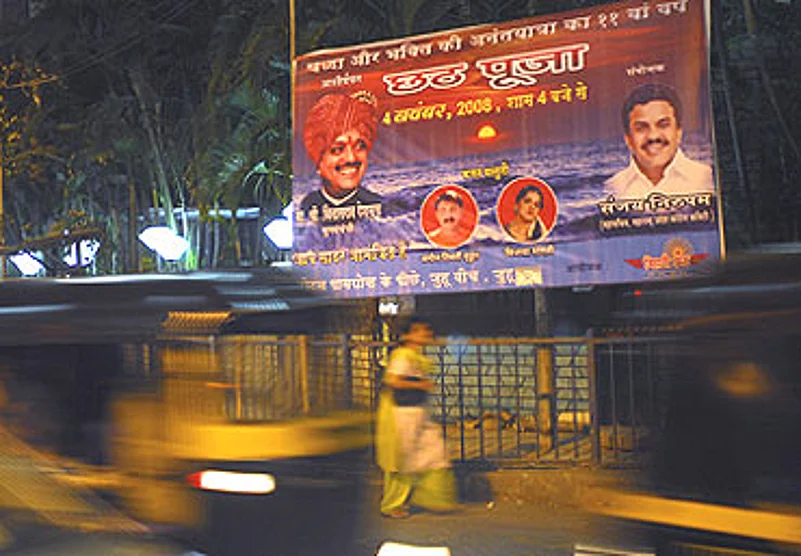
MUMBAI
To Be AnUttar Bharatiya...
To be Barack Hussein Obama in the United States of America now means a millionhappy things to his ilk. To be a Shiv Narayan Yadav in Mumbai these days meansmany things that none of his ilk would wish for themselves...
SMRUTI KOPPIKAR
To be BarackHussein Obama in the United States of America now means a million happy thingsto his ilk. To be a Shiv Narayan Yadav in Mumbai these days means many thingsthat none of his ilk would wish for themselves.
Yadav, by virtue of fulfilling domicilerequirement of 15 years, is a Mumbaikar but could be labeled a migrant. Eitheris an identity, either can be picked upon to suit political ends. Being amigrant anywhere is not easy, much less so in a harsh, crowded, pragmatic to afault, money-is-honey city like Mumbai. It offers him a half life – a bedshared by three people in turns through 24 hours, 12 inches of space on aclothing line, kitchenette just large enough to store a couple of plates-katorisand a stove to make chai, a corner for pooled-in-and-bought television set towatch Bachchan and Bhojpuri. Yet, migrants flock because Mumbai offers them morethan half a chance to make a living. This, after all, is a city built bymigrants over two centuries. Over years, depending on political whims, migrantsfrom various parts of the country were made to feel unwelcome by those whoclaimed a certain amorphous ownership over Mumbai. Now, in the Raj Thackerayera, it is particularly difficult being a migrant from Uttar Pradesh and Bihar.And, the difficulty has nothing to do with crowded trains and cramped livingspaces.
- To be an Uttar Bharatiya – literally north Indian, but taken to mean those from UP-Bihar – is to wish for a time when the term itself was innocent.
- To be tagged an Uttar Bharatiya in Mumbai now is probably many degrees worse than being one
- To be an Uttar Bharatiya now means living in perpetual anxiety even within ones’ own basti.
- To be an Uttar Bharatiya in Mumbai now means watching political games being played in one's name.
- To be an Uttar Bharatiya in Mumbai today means that you belong to the bottom zones of the socio-economic ladder.
- And, to be an Uttar Bharatiya in Mumbai now means having to measure your words, weigh your attitudes and re-examine your options.
- To be an Uttar Bharatiya in Mumbai now means to return to your forefathers’ village, looking for land to work out a Plan B
- To be an Uttar Bharatiya in Mumbai now means seeking solace and security in the confines of your own Bhaiyya and Bihari bastis
- To be an Uttar Bharatiya in Mumbai now means scaling down the celebrations of your festivals, lest it is mis-interpreted and twisted out of context.
- To be an Uttar Bharatiya in Mumbai now means forsaking the Bhojpuri films lest there is violence at the theatre.
- To be an Uttar Bharatiya in Mumbai now means hunting for Marathi language classes, teach-me-Marathi books.
- To be an Uttar Bharatiya in Mumbai now means that you have become part of the city’s slang. “Abbey Bhaiyya” and “Abbey Bihari” are the cuss words to end street corner arguments and throw the way of errant drivers.
- To be an Uttar Bharatiya in Mumbai means to be unsure if you and your children will be made to feel, increasingly, as second-class citizens in a land that’s as much yours as that of Maharashtrians
- To be an Uttar Bharatiya in Mumbai now means you wonder at the silence or near-silence of the moderate non-Raj kind of Maharashtrians
- To be an Uttar Bharatiya in Mumbai means you long for a city that, not too long ago, was home.

Till not more than a year ago, it was not apejorative label, not heard, seen, read in Mumbai as disparagingly and widely asit is today. When it was used, it meant little other thansomeone hailing from the north of India. Now, the innocent term has acquiredundesirable nuances. “Ab chhati thok ke kehna ki hum Uttar Bharatiya hainka matlab hua ke hum kisiko chunauti de rahe hain, halanke aisa kuch bhi nahinhoga,” (To proudly declare that I am an Uttar Bharatiya now means throwinga challenge to someone who is not, though I do not mean it that way at all)whispers Shiv Narayan Yadav, who migrated to the then Bombay over 40 years back,setting up his vegetable stall in Mumbai’s Vile Parle market, among Mumbai’soldest and third-largest mandis after Dadar and Byculla.
The suburb of Vile Parle, on the east side, ispucca Maharashtrian. Yadav points out that all vegetable and fruit vendors therehave been Uttar Bharatiyas for decades together. ‘Hum to grahak se kuchkuch Marathi bhi bol lete hain,” (We attempt to speak some Marathi withour regular customers) he says. “Lagbhag chaalees saalon ke baad, koi hameyeh to bataye ki hum gair-Marathi, gair-Mumbaikar kaise hue,” (After 40years here, will someone enlighten me on how I suddenly turned non-Mumbaikar).Yadav asserts that the term Uttar Bharatiya means his roots, his distant past,his origin; Mumbai is his present, his wealth, his life, his future. A quirk offate, he says, that after servicing Maharashtrians for decades his prevailingidentity should be that of an Uttar Bharatiya. Yadav cannot make much sense ofthis; he only wishes the storm will blow over.
Ram Narayan exemplifies this dilemma. ShivNarayan’s call centre-employed son shows the bitterness that the older manmasks. “Till the other day I was a Mumbaikar, no one even bothered to askwhich part of Uttar Pradesh I came from. I was born here, brought up here. Now,suddenly I am not so much a Mumbaikar but an Uttar Bharatiya,” fumes RamNarayan. He narrates how his colleagues, educated at least till the graduatelevel, seem to have re-aligned themselves into community and language basedidentities. “Marathi speaking friends hang out together. UPwallahas hang outtogether, separately,” he says. There are many thousands in the UttarBharatiya population – estimated at between six and seven million ofMumbai’s total 17 million – who would not answer to the call of an UttarBharatiya. Their roots may lie somewhere in Benares or Balia, but their birthcertificates are issued in Marathi. This segment finds the controversy hardestto stomach.
“I have no real home to return to, do youunderstand,” asks the well-turned out Shivpal Singh with a rage that RajThackeray should begin taking note of, “I was born here to parents from UP. Iam Mumbai and Mumbai is me.” The strapping 21-year-old who took a degree thisJune is looking for a job. “Do you think I will get one in this scenario?”he asks rhetorically. At the other end of the socio-economic spectrum is SantlalYadav, who has been here since he was seven. At 40, he has a modest electricalbusiness servicing repairs in high-end suburban apartments, and a family that heraised in a Mumbai slum. “My young kids do not even properly say the name ofour village near Benares. I hardly go there. There’s some land in our name butI have no real connection. I am considered an outsider here and I will be seenas an outsider there too.”
This section is what Kripa Shankar Singh terms“nobody’s children”. Singh, who started out as potato-onion vendor inSantacruz bylanes in the 70s and rose to become minister of state for home inthe Maharashtra cabinet last term, is presently Mumbai Congress chief.“Identity politics has gone on too far, it’s touching and scarring the livesof millions whose only concern is to seek a better life within the parametersset by the Constitution of India. Our government allowed too much latitude toRaj Thackeray.” Singh knows he will have to undertake an immense amount ofdamage control initiatives if the Congress is to do well in the next assemblyand general election. But his deepest distress is about the fault-lines that aredrawn. “Mera beta Mumbaikar hai, main Mumbaikar hoon uta his jitna Raj hain.Ab kaun kisko certificate dega,” (My son is a Mumbaikar, I am one too,just as Raj is. Who is to give a certificate to whom)

It is no one’s case that Uttar Bharatiyas arebeing identified and harmed by scores all across Mumbai. Statistically speaking,the few sorry incidents do not count as having touched even 0.5 per cent of thecommunity. The couple of taxis vandalized, bhelpuri stalls uprooted frompavements, Dharmadev Rai being beaten up in a local train, and so on –repeated ad nauseum on television screens to wrongly reflect the entire city andits citizens – represent the worst that happened. They are, undeniably,unbecoming of a multi-cultural and pluralistic city like Mumbai. Taken togetherwith reports that scores of Uttar Bharatiyas from Pune, Nashik and other citieshave left for their hometowns, they point to an utter and willful neglect of lawand order by the state machinery. However, through all this, millions of UttarBharatiyas have lived their lives as they otherwise would, doing all that theywould, going to all those suburbs and places as they would, engaging in theirwork and leisure pursuits. The difference between pre-Raj and post-Raj era is sosubtle, so insidious and so very gradual that many non-Uttar Bharatiyas havemissed it. The difference is not the violence per se, but the anticipation andanxiety of violence anytime anywhere.
The unspoken, almost indiscernible, differenceshows in the manner of living, in the cadences of everyday life. Wives areanxious about husbands going off on their trades. Women are apprehensive thatsome “sarphira” speaking in Marathi will storm into their bastiwhen the men are away. Men worry about what lies in store for them at workplaces– the dairies, the vegetable and fruit mandis, the security offices, telephoneoffices, railway counters and so on. Children in their teens, even pre-teens,approach the neighbourhood cricket gully with some trepidation at remarks thatare sure to come their way. The family from UP or Bihar who now takes thesuburban local is wary of co-commuters, some even yanking their little childrenoff from the window seat to offer it a man who obviously is a Maharashtrian. Theneighbourhod ubiquitous bhelpuriwallah, whose favourite parking place was nearthe Shiv Sena office, now wonders if he should move to a “safer” corner upahead on that street, or to another street altogether. Every other taxi driverwonders if he should venture into certain areas for his fares. Autorickshawowners, many of them, drivers themselves, have to put up with the odd passengerwho will terminate the ride with a slap instead of the metered fare because heis “a bloody Bihari”. Autorickshaw owners debated if they should “buyover” Raj Thackeray’s goodwill by sending him Diwali mithai. Security guardsin modest to upscale housing societies face the prospect of being replaced bytheir Maharashtrian counterparts. Commercial transporters wonder if they shouldpen Marathi catch-phrases at the back of the trucks and vans. Film industryworkers are anxious. Zari factories, neighbourhood atta chakkis, carpenters andpainters, all worry if they will function as they always have. The door-to-doorfishwallah, who replaced the traditional Maharashtrian Koli women vendors, arescared that their trade will be snatched away. And so on, it goes….
The below-surface but continuous state of anxietyis a barometer of how Raj Thackeray’s campaign has devoured into the typicalMumbai life. “They don’t feel safe, comfortable, at home, anymore. UttarBharatiyas are constantly looking over the shoulder for that Raj-typeMaharashtrian though the fact remains that Mumbai runs on their services,”says Sanjay Nirupam, former Shiv Sena MP and Thackeray-acolyte, now Congressspokesperson in the state, who was instrumental in organizing the Chhat Pujafour-five years back on the scale that made Raj see red. “I say this not asdefiance, but as the truth. Yeh Uttar Bharatiya pura shahar ko dho rahe hain.Aap inko nikal do, Mumbai bandh pad jayege” (They carry the burden of tecity. Throw them out and Mumbai will come to a grinding halt). Rues VishwanathSachdev, noted Hindi journalist, political commentator and writer, “What ishappening is a dangerous threat to Mumbai’s composite culture.”
Kurar village in suburban Malad is an UttarBharatiya settlement. Poisar village bridging the suburbs of Kandivli andBorivli in far north Mumbai is home to not less than a lakh Biharis. Across thecity’s suburbs are pockets of Bihari and UP homes, ghettos if you like. Evenin their own bastis now, the anxieties and apprehensions are palpable. “I sentmy wife and kids to UP for Diwali and stayed out of the basti as far aspossible. Who knows what shape a regular basti fight will take,” says BhimSingh, a security guard, whose neighbouring basti comprises Maharashtrians. Indowntown city, at the famous Mahalakshmi dhobhighat, Rakesh Gupta islivid that he must account for yet another variable in his otherwise unsettledlife. “My grandfather migrated to Mumbai. My father was born here. I was bornhere. I sell fish. My brothers work at the dhobhighat. This is the only life andhome I have, but when Raj’s men came here they threatened to come again if wedidn’t take the next train to UP,” says Gupta. None from this biradari havetaken that train, but a few are weighing the option. Sachdev and other worrythat this kind of social disturbance may explode in ways we cannot now imagine.

The man-on-the-street Uttar Bharatiya is astuteenough to recognize that politics and political one-upmanship lie at the heartof this unnecessary campaign against his identity. If he is unforgiving of RajThackeray and the Maharashtra Navnirman Sena, he is equally critical of thestream of politicians – Mulayam Singh, Amar Singh, Mayawati, Lalu Prasad Yadav,Ram Vilas Paswan, Nitish Kumar – who have descended upon Mumbai quiteregularly during the last four-five years to either establish or consolidatetheir base here. “Yeh sab to rajniti ka khel hain” (All this is apolitical game), says Bharat Singh who has lived 30 of his 39 years in a Mumbaibasti and works as a security guard. He can tell how many times so-calledworkers of either Mulayam’s SP or Mayawati’s BSP have come into his basti,offered people inducements to attend rallies and so on. He can also tell storiesof those local Congressmen who tried to compete with the UP leaders.
After the de-limitation exercise, Mumbai andThane account for nearly 70 seats in the state legislature, almost 80 per centof them in urban areas. The Uttar Bharatiya vote can make a difference betweenwinning and losing in as many as 40-43 seats, according to a Congress internaldossier. This is the piece of the pie that Mayawati, Mulayam Singh and LaluPrasad Yadav, all are eyeing as the springboard to make their base in Mumbai.This is typically their voter back home in UP and Bihar; his support in Mumbaiis priceless when they seek to establish themselves in the city. Leadersunabashedly used festivals and occasions to promote their brand of politics. So,UP divas was celebrated in a big way by the SP. Chhat Puja had Nirupam’s andCongress’ blessings. However, the typical SP/BSP or RJD voter back home hasbeen, traditionally, a Congress voter here in Mumbai. “Whoever forms the nextgovernment in Maharashtra will have taken the north Indian vote with him.Otherwise it’s not possible,” argues Nirupam. Arch rival Kripa Shankar Singhagrees. Between them is a royal battle to be the voice of the Uttar Bharatiyawithin the Congress!
The Shiv Sena, recognizing the significance ofthe Uttar Bharatiya vote, made several overtures to the community through theirbusiness leaders, community organizations, festival committees and so on. UddhavThackeray imagined that his inclusive “Mee Mumbaikar” campaign would nullifyyears of the Sena’s antagonism towards the community. All this while, theCongress was hard put to dream up strategies to win the Marathi vote which isequally crucial in certain pockets of Mumbai and Thane. Into this cauldronstepped in Raj Thackeray, who saw the potential of crystallizing the Marathivotebank for himself, at the expense of every other political party in thestate. The Sena is caught between the Marathi and Uttar Bharatiya vote. TheCongress, which happily allowed Raj to knock its principal opposition the Sena,now risks losing its appeal among Uttar Bharatiyas after it dragged feet onaction against Raj. “Who speaks for us now? Those who do so in Delhi are doingit for their own ends too,” remarks Saheblal Pandey, autorickshawowner-driver, who can recite the Gita and who educated his son to join the elitenuclear establishment BARC here.
There is a Prakash Jha in the Mumbai filmindustry whose affection for his native Bihar is up there for all to see. Thereis a Shekhar Suman who had rarely hidden his Bihari roots. There is an AmitabhaSingh, from Benares, whose cinematography skills are in much demand by theadvertising and film industry. There are scores of others, hailing from UP andBihar, spread across the entertainment world, the corporate sector, the serviceindustries and the like. Raj’s campaign, though centred briefly on theBachchans and Bhojprui star Manoj Tiwari to gain maximum national publicity, hascleverly stayed away from the upper ends of the socio-economic ladder. Theanti-Uttar Bharatiya sentiment is directed against the lower and lower-middleclass Uttar Bharatiya by his Maharashtrian counterpart.
The anti-Uttar Bharatiya campaign makes me hangmy head in shame, remarked the noted Marathi author Dilip Chitre, writing inHindi. Its focus on the poorest of the poor, the most defenseless and voiceless,the weakest link in the economic chain like the factory workers and constructionlabour, is a barely-disguised class war under the garb of a regional identitycampaign. “It is easier to stoke the poor out-of-work Marathi youth to runamok against the Uttar Bharatiya than to provide him with skills and jobs,”says Dr R Tiwari, former head of Hindi department in the University of Mumbai.Some Maharashtrian commentators could not agree more. These are people who wantto remind Raj, and others like him, that priests were specially invited fromBenares to lead Chhatrapati Shivaji’s coronation. Even if, to give Raj thebenefit of doubt, the Railway carried an anti-Marathi bias in its recruitment,there is hardly any justification for the fact that nearly 40 different servicesin the city are controlled by Uttar Bharatiyas who sensed and seized theopportunities as they came. Raj’s response, briefly, was to organize classesto teach Maharashtrians the art of bhel-making. It fizzled out.
















